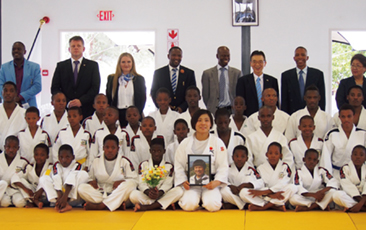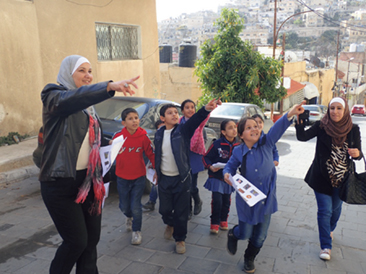(6) Culture and Sports
In developing countries, there is a growing interest in the preservation and promotion of their own cultures. Cultural heritage that symbolizes a country is a source of pride for people, and that can be effectively utilized for tourism to develop the socio-economic environment of the residents in the surrounding areas. On the other hand, there are also a number of cultural heritage sites that are exposed to survival crises due to lack of funds, equipment, technology, etc. Assistance to protect cultural heritage is a form of cooperation that directly reaches the hearts of the people in those countries, and has long-term effects. In addition, the preservation and promotion of culture, such as invaluable cultural heritage that is shared by all humankind, is an issue that should be addressed not only by the countries with cultural heritage in danger, but also by the entire international community.
Everyone is familiar with sports, and can easily take part in them regardless of their gender or age. Sports can enhance people's quality of life as they help maintain and improve health. Furthermore, sports foster a sense of respect for opponents, as well as cultivate a spirit of mutual understanding and awareness of norms, through competition based on fair rules and sharing of the same experience. The influence and positive power of sports play the role of “catalyzer” for the development and growth of developing countries.
<Japan's Efforts>
Japan has contributed to promotion of culture and higher education as well as preservation of cultural heritage in developing countries through Cultural Grant Assistance* program since 1975. Specifically, Japan has constructed facilities necessary for preserving and utilizing cultural heritage and cultural properties, sports and cultural facilities, and facilities of higher education and research institutions in developing countries. Japan has also provided necessary equipment for these facilities. Those facilities built in developing countries serve as centers for providing information on Japan and for cultural exchanges with Japan, as well as for deepening understanding of Japan and fostering a sense of affinity towards Japan. In recent years, from the viewpoint of “Japan promotion,” Japan has also emphasized support for Japanese language education and support that contributes to disseminating Japanese contents.
In FY2016, Japan kept up its proactive efforts to provide sports assistance using ODA and “Projects for Sports Diplomacy Enhancement” to advance “Sport for Tomorrow,” a program launched for the purpose of international contribution through sports, with which Japan shares sporting values and spreads the Olympic and Paralympic movement as the host country of the Olympic and Paralympic Games Tokyo 2020. Specifically, Japan has provided sports facilities and equipment to 12 countries within the framework of Japan's Cultural Grant Assistance and has dispatched 241 JICA volunteers in the fields of sports in total so far. Japan has also decided to utilize Grant Assistance to assist in improvement of facilities and equipment to Palestine and other countries. In addition to the above, Japan provides TV programs in three countries.
•Botswana
The Project for Judo Dojo Construction
Grant Assistance for Cultural Grassroots Project (February 2016 - February 2017)
Botswana Judo Federation promotes the sport of Judo in Botswana as the only Judo-related organization in the country. Thanks to the Judo instruction by Mr. Keisuke Itsubo, a Japan Overseas Cooperation Volunteer who passed away due to an accident in 2014, Botswanan Judo athletes have now become active in international competitions mainly in Africa.
However, Botswana did not have even one dedicated Judo dojo (Judo training hall) for athletes to practice in. Instead, athletes had to lay tatami mats in a dark and narrow space under the stands of the Botswana National Stadium to hone their Judo skills. In the national competitions, athletes had to bring their own tatami mats to public facilities such as elementary schools. Needless to say, not having a dedicated dojo created a major roadblock to the promotion of the sport as well as advancing athletes' skills.

Ms. Tachimoto holding a picture of the late Mr. Itsubo with Judo officials at the completed dojo
In reaction to Botswana's request to help rectify this situation, Japan decided to assist the country in order to build a dedicated Judo training hall under a Grant Assistance for Cultural Grassroots Project. With the sponsorship of the International Judo Federation as well as the support of the family of Mr. Itsubo, the completed Judo training hall was named “Sensei (teacher) Itsubo Memorial Dojo,” and a handover ceremony was held on February 28, 2017. Notably, the ceremony was attended by Ms. Haruka Tachimoto, a friend of Mr. Itsubo from university, and gold medalist at the Rio 2016 Olympics. Donations of Judo uniforms were also presented by Judo associations in Japan.
Currently, Botswanan athletes are working hard in practice at this Judo training hall aiming to participate in the 2020 Tokyo Olympic Games. Also, various competitions and referee training courses have been held there. Moreover, as a result of raising interest in Judo, a new Judo class for local community members was launched.
Japan supports restoration and preservation of cultural heritage, including equipment provision and preliminary studies and surveys, through the Japanese Funds-in-Trust for Preservation of the World Cultural Heritage established in UNESCO. Placing a particular emphasis on human resources development in developing countries is based on the idea of enabling people in these countries to protect the cultural heritage of their own country by themselves in the future, Japan also endeavors to dispatch international experts who are Japanese experts, and hold workshops in order to transfer technology and expertise to developing countries. In addition to tangible cultural heritage, Japan also supports safeguarding of intangible cultural heritage such as traditional dances, music, handcraft techniques, and oral lore (oral traditions) by implementing successor training, records conservation, creation of safeguarding mechanisms, and other activities through the Japanese Funds-in-Trust for the Safeguarding of the Intangible Cultural Heritage established in UNESCO.
The Ministry of Education, Culture, Sports, Science and Technology (MEXT) implements the Cooperation Promotion Program for the Protection of World Heritage and Other Cultural Properties in the Asia-Pacific Region, through which it invites young experts on cultural heritage protection from the Asia-Pacific region to Japan for training.
- *Cultural Grant Assistance
- Cultural Grant Assistance provides funding to procure equipment and supplies, and improve facilities for the promotion of culture and higher education in developing countries. It is intended to encourage cultural and educational advancements in these countries as well as cultural exchanges between Japan and the countries, with a view to deepening friendships and mutual understanding. Cultural Grant Assistance includes General Cultural Grant Assistance, which provides assistance to governmental organizations, and Grant Assistance for Cultural Grassroots Projects, which provides assistance to NGOs and local public entities for small-scale projects.
•Jordan
Sustainable Community Tourism Development Project in As-Salt City
Technical cooperation project (September 2012 - August 2016)
Jordan has few natural resources. The tourism industry focused on its cultural heritage sites and natural environment such as the Dead Sea is one of the principal industries underpinning economic stability and development. Japan has continuously supported the development of Jordan's tourism industry for many years, utilizing various schemes to help build tourism facilities and dispatch experts on tourism development through loan aid and grant aid.
As-Salt city, which flourished through trade and commerce in the late 19th century, is a historical town with a unique cultural identity and buildings crafted from the area's yellow limestone at that time. Unlike other cities focused on archeological sites, As-Salt finds value in its tourism resources as a heritage city that has consistently passed down the scenery and lifestyles together of a bygone era. However, the city was unable to fully develop these tourism resources. Therefore, Japan implemented a tourism development project for As-Salt based on the concept of an “eco-museum”*, designed by drawing on the experience of the “city-wide Open Air Museum” -the citizen-participatory tourism model of Hagi City, Yamaguchi Pref.

A walking tour led by local guides
In this project, Japan provided support in various ways: facilitating participatory initiatives such as home visits through which traditional culture can be experienced and the development of walking route based on religion and daily lifestyles; giving support for the establishment of development of tourist souvenirs including a specialty shop carrying local items; in addition, providing assistance to enhance tourism promotion skills. As a result, visitors to As-Salt's historical museum, which had averaged around 3,000 visitors, increased to almost 5,000 people in 2017. Walking tours routes were expanded from one to three, and trained local guides lead these walking tours route while introducing the town's history and culture. Furthermore, the number of local brands producers have increased, and they opened a specialty shop carrying their items. They are contributing to the activation of the local economy.
These initiatives were highly praised for not only contributing to Jordan's economic development, but also fostering pride in the community among local people and raising their awareness about tourism. Even after the project ended, using the knowledge and know-how gained from Japan's assistance, As-Salt City is now working towards becoming listed on the UNESCO World Heritage List.
*An eco-museum designates part of a community as an open air museum in which local residents participate to preserve, conserve, exhibit, and utilize the community's nature, culture (buildings and tools, etc.) and lifestyle using sustainable means.
